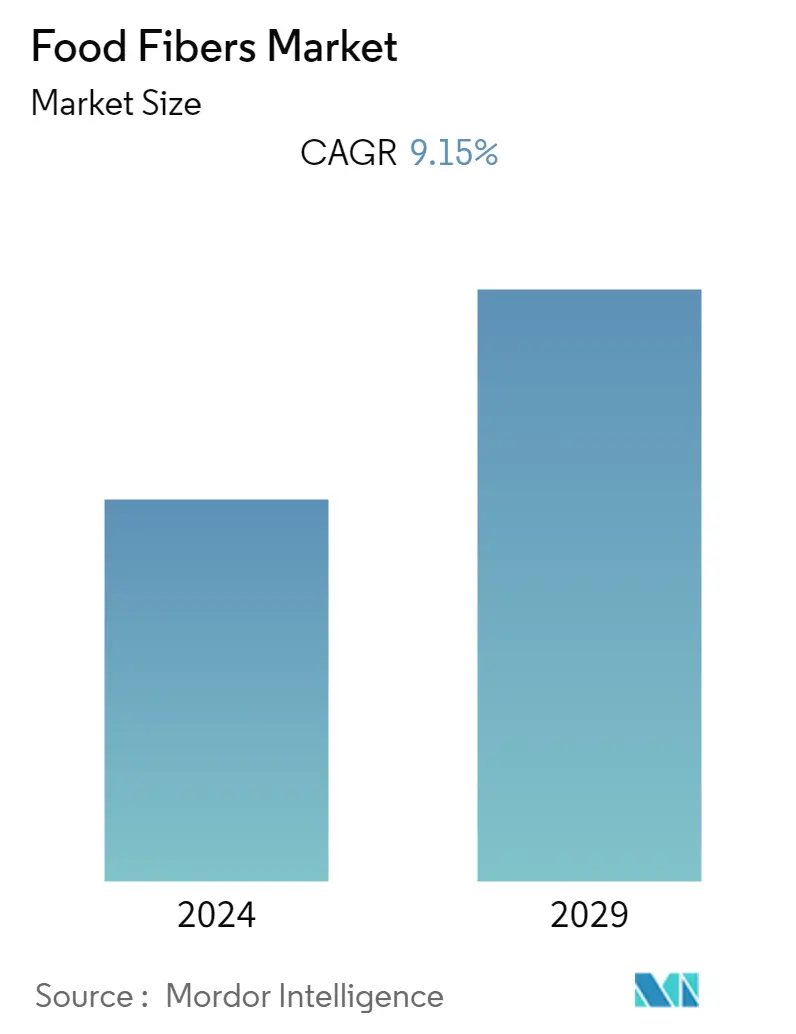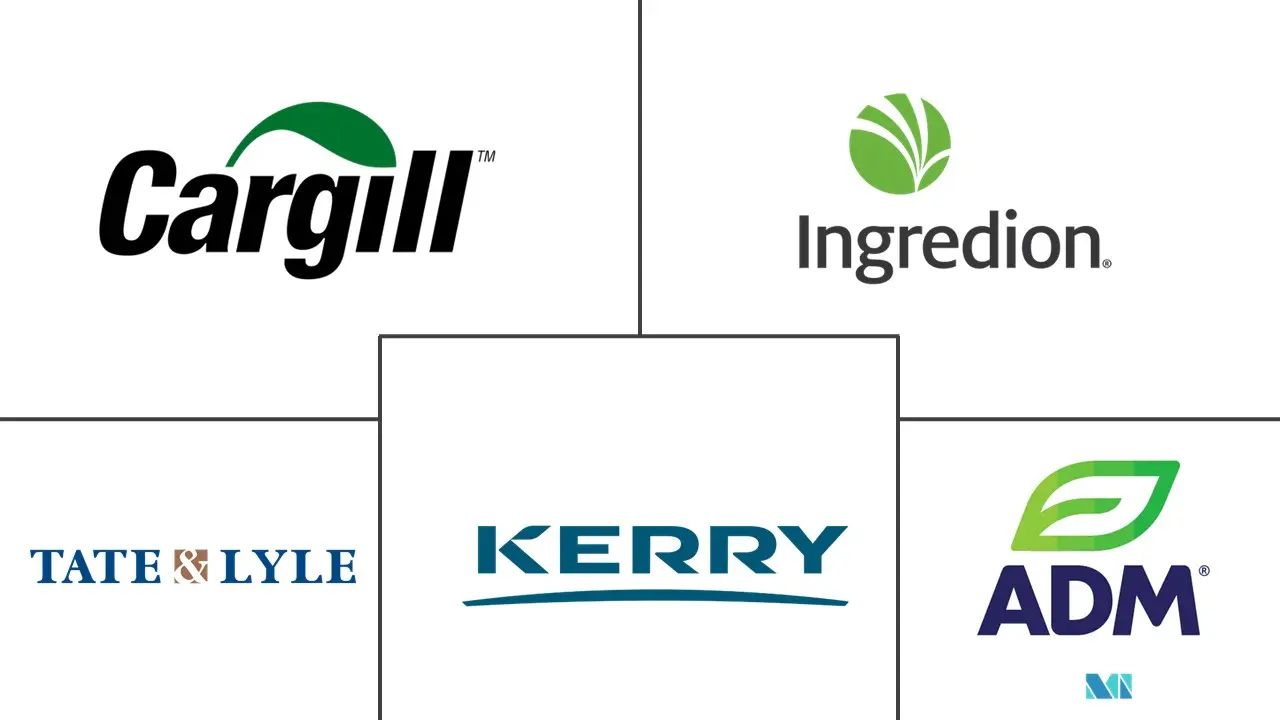Market Size of Food Fibers Industry

| Study Period | 2018 - 2029 |
| Base Year For Estimation | 2023 |
| CAGR | 9.15 % |
| Fastest Growing Market | Europe |
| Largest Market | North America |
| Market Concentration | Low |
Major Players
*Disclaimer: Major Players sorted in no particular order |
Food Fibers Market Analysis
The Global Food Fibers Market is projected to register at a CAGR of 9.15% over the next five years.
Over the last couple of years, there has been an increase in the demand for nutritionally significant food by consumers. Since the awareness about the benefits of food fibers on health has become more prevalent over the past few years, the consumption of food fibers has also increased significantly. Health-conscious consumers are taking proactive and preventive measures for their health owing to increased awareness between a healthy gut microbiome and immune function, metabolic wellness, digestive health, and mental well-being. Fiber is a functional ingredient that supports the microbiome.
Thus, according to the 2021 Food and Health Survey from the International Food Information Council (IFIC), over 56% of consumers added or increased fiber content in their diet. While most consumers (92%) seek to get fiber from food, one in five still supplement their diet with fiber supplements. Additionally, the growth of the food fiber industry is augmented by its fortification in shelf-stable food products, such as natural alternative sweeteners, like monk fruit extracts, stevia, shelf-stable bars, cereal, chips, pretzels, and other snacks. Moreover, protein supplements and meal replacement options incorporated dietary fibers from diverse sources, such as nuts, seeds, and chicory root.
Food Fibers Industry Segmentation
Food fiber, also known as dietary fiber, is a group of compounds found in plants that cannot be fully digested in the human gut. Commercially, fibers are derived from fruits and vegetables and can be isolated or modified after processing. The food fibers market is segmented into type, application, and geography. By type, the market is segmented into soluble and insoluble fibers. The soluble fibers segment is further divided into inulin, pectin, polydextrose, beta-glucan, and other soluble fibers. The insoluble fibers are segmented into cellulose, lignin, hemicellulose, chitin and chitosan, resistant starch, and other insoluble fibers. Based on application, the market is segmented into food and beverages, dietary supplements, and pharmaceuticals.
Further, based on food and beverage application, the market is segmented into bakery and confectionery, dairy, meat, poultry and seafood, beverages, and other food and beverage products. By geography, the report analyses the major economies of North America, Europe, Asia-Pacific, South America, the Middle East & Africa. For each segment, the market sizing and forecasts have been done based on value (in USD million).
| Type | ||||||||
| ||||||||
|
| Application | |||||||
| |||||||
| Dietary Supplements | |||||||
| Pharmaceuticals |
| Geography | |||||||||
| |||||||||
| |||||||||
| |||||||||
| |||||||||
|
Food Fibers Market Size Summary
The global food fibers market is experiencing significant growth, driven by increasing consumer awareness of the health benefits associated with dietary fibers. As more individuals prioritize health and wellness, there is a notable shift towards high-fiber foods, which are recognized for their role in supporting gut health, immune function, and overall metabolic wellness. This trend is further supported by the fortification of food products with fibers, such as natural sweeteners and snacks, as well as the incorporation of fibers from sources like nuts and chicory root in protein supplements and meal replacements. The market is also benefiting from initiatives like the UK's "Action on Fiber," which aims to boost fiber consumption, and the adoption of clean-label and plant-based products, particularly in Europe.
The competitive landscape of the food fiber market is characterized by the presence of major players such as Cargill, Archer Daniels Midland Company, Kerry Inc., Ingredion Incorporated, and Tate & Lyle, who are actively expanding their market share through strategic acquisitions, product innovations, and geographical expansion. Recent developments include Cargill's introduction of a soluble corn fiber ingredient and Tate & Lyle's acquisition of a prebiotic manufacturer, highlighting the industry's focus on enhancing product offerings and meeting the growing demand for dietary fibers. The market's growth is further supported by regulatory developments, such as the UK Food Standards Agency's recognition of inulin as a dietary fiber, which encourages manufacturers to promote high-fiber content in their products.
Food Fibers Market Size - Table of Contents
-
1. MARKET DYNAMICS
-
1.1 Market Drivers
-
1.2 Market Restraints
-
1.3 Industry Attractiveness - Porter's Five Forces Analysis
-
1.3.1 Bargaining Power of Suppliers
-
1.3.2 Bargaining Power of Consumers
-
1.3.3 Threat of New Entrants
-
1.3.4 Threat of Substitute Products
-
1.3.5 Degree of Competition
-
-
-
2. MARKET SEGMENTATION
-
2.1 Type
-
2.1.1 Soluble Fibers
-
2.1.1.1 Inulin
-
2.1.1.2 Pectin
-
2.1.1.3 Polydextrose
-
2.1.1.4 Beta-glucan
-
2.1.1.5 Other Soluble Fibers
-
-
2.1.2 Insoluble Fibers
-
2.1.2.1 Cellulose
-
2.1.2.2 Lignin
-
2.1.2.3 Hemicellulose
-
2.1.2.4 Chitin and Chitosan
-
2.1.2.5 Resistant Starch
-
2.1.2.6 Other Insoluble Fibers
-
-
-
2.2 Application
-
2.2.1 Food and Beverage
-
2.2.1.1 Bakery and Confectionery
-
2.2.1.2 Dairy
-
2.2.1.3 Meat, Poultry, and Seafood
-
2.2.1.4 Beverages
-
2.2.1.5 Others
-
-
2.2.2 Dietary Supplements
-
2.2.3 Pharmaceuticals
-
-
2.3 Geography
-
2.3.1 North America
-
2.3.1.1 United States
-
2.3.1.2 Canada
-
2.3.1.3 Mexico
-
2.3.1.4 Rest of North America
-
-
2.3.2 Europe
-
2.3.2.1 United Kingdom
-
2.3.2.2 France
-
2.3.2.3 Germany
-
2.3.2.4 Italy
-
2.3.2.5 Russia
-
2.3.2.6 Spain
-
2.3.2.7 Rest of Europe
-
-
2.3.3 Asia-Pacific
-
2.3.3.1 China
-
2.3.3.2 Japan
-
2.3.3.3 Australia
-
2.3.3.4 India
-
2.3.3.5 Rest of Asia-Pacific
-
-
2.3.4 South America
-
2.3.4.1 Brazil
-
2.3.4.2 Argentina
-
2.3.4.3 Rest of South America
-
-
2.3.5 Middle-East and Africa
-
2.3.5.1 Saudi Arabia
-
2.3.5.2 South Africa
-
2.3.5.3 Rest of Middle-East and Africa
-
-
-
Food Fibers Market Size FAQs
What is the current Food Fibers Market size?
The Food Fibers Market is projected to register a CAGR of 9.15% during the forecast period (2024-2029)
Who are the key players in Food Fibers Market?
Ingredion Incorporated , Cargill, Incorporated, Kerry Group PLC, Tate & Lyle PLC and Archer Daniels Midland Company are the major companies operating in the Food Fibers Market.

